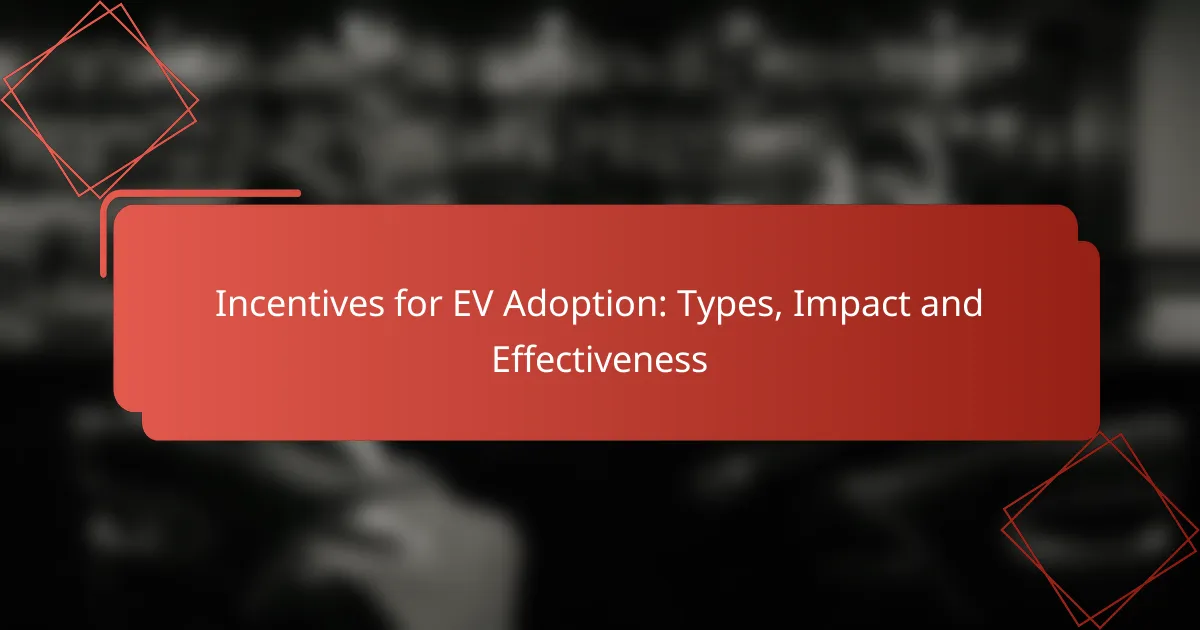Incentives for electric vehicle (EV) adoption play a crucial role in promoting the transition from traditional vehicles to cleaner alternatives. By offering financial benefits such as tax credits and rebates, these incentives lower the overall cost of EV ownership and stimulate consumer interest. Evaluating their effectiveness through sales growth and consumer satisfaction metrics provides valuable insights into the impact of these initiatives on the market.
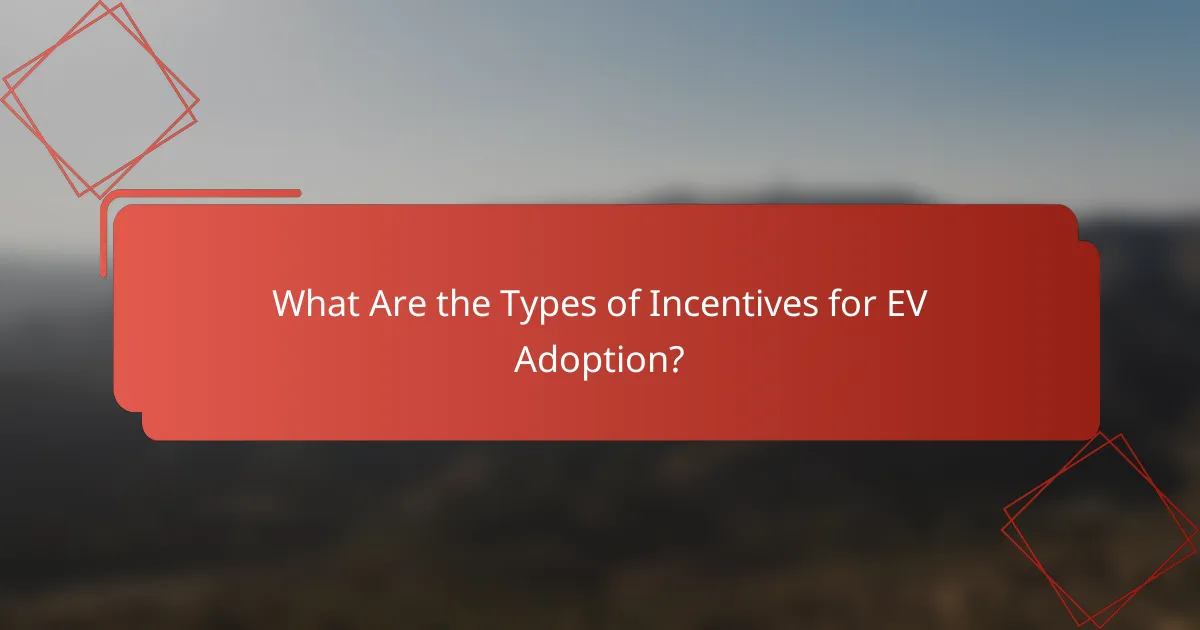
What Are the Types of Incentives for EV Adoption?
Incentives for electric vehicle (EV) adoption can be categorized into financial and non-financial types. These incentives aim to lower the cost of purchasing EVs and encourage consumers to make the switch from traditional vehicles.
Financial incentives
Financial incentives are direct monetary benefits provided to consumers to reduce the overall cost of purchasing an electric vehicle. These can include various forms of financial support from government bodies or private organizations aimed at making EVs more affordable.
Examples of financial incentives include low-interest loans, discounts on vehicle purchases, and funding for charging infrastructure. These incentives can significantly lower the upfront costs associated with buying an EV, making them more appealing to potential buyers.
Tax credits
Tax credits are reductions in the amount of income tax owed, directly benefiting EV purchasers. In many regions, buyers can receive substantial tax credits when they purchase qualifying electric vehicles, which can range from a few thousand to several thousand dollars.
For instance, in the United States, federal tax credits for EVs can be as high as $7,500, depending on the vehicle’s battery capacity. It’s essential for buyers to check eligibility requirements, as these can vary by state and vehicle model.
Rebates
Rebates are cash-back offers provided after the purchase of an electric vehicle, effectively lowering the purchase price. Many local and state governments offer rebates to incentivize EV adoption, which can be applied at the point of sale or claimed later.
Rebate amounts can differ widely; for example, some states may offer rebates of up to $5,000. Buyers should verify the specific rebate programs available in their area, as these can change frequently.
Grants
Grants are funds provided by government entities or organizations to support the purchase of electric vehicles or the development of charging infrastructure. Unlike loans, grants do not require repayment, making them a valuable resource for potential EV buyers.
Grants may be available for both individual consumers and businesses looking to invest in electric fleets. Interested parties should explore local government websites or environmental organizations for available grant opportunities.
Non-financial incentives
Non-financial incentives include benefits that do not involve direct monetary compensation but still encourage EV adoption. These can include access to carpool lanes, free parking, and exemptions from certain fees or tolls.
For example, many cities allow electric vehicles to use high-occupancy vehicle lanes, which can significantly reduce commute times. Additionally, some regions offer free or discounted charging at public stations, enhancing the convenience of owning an EV.
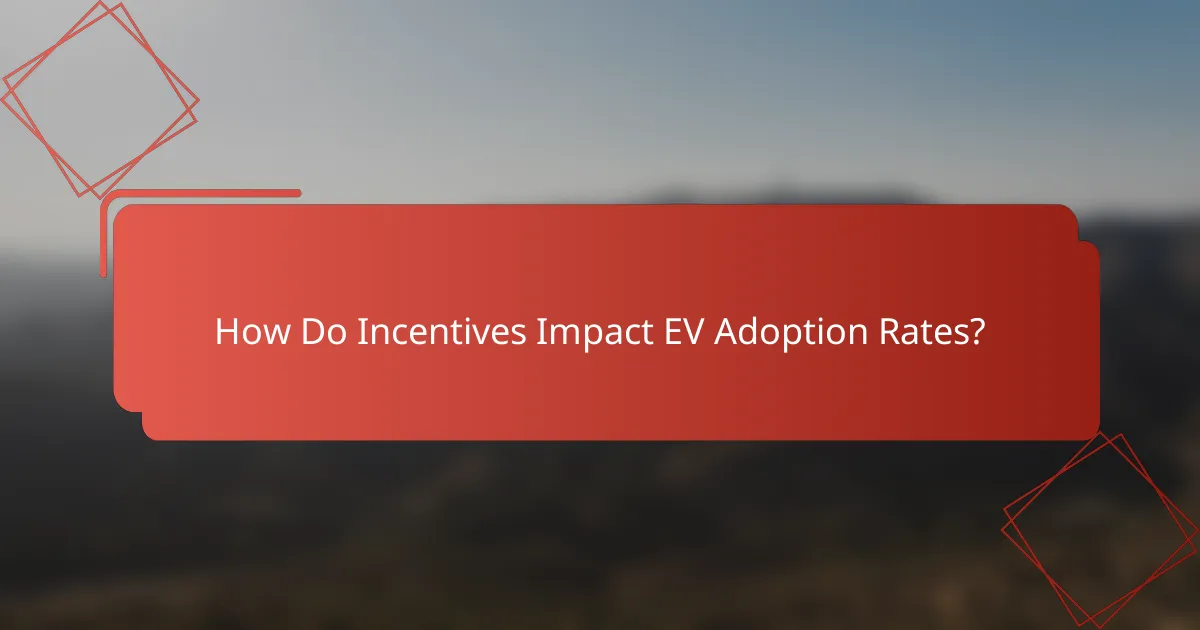
How Do Incentives Impact EV Adoption Rates?
Incentives significantly boost electric vehicle (EV) adoption rates by lowering upfront costs and enhancing consumer interest. These incentives can take various forms, including tax credits, rebates, and grants, which make EVs more financially attractive to potential buyers.
Increased sales
Financial incentives lead to increased sales of electric vehicles by reducing the overall purchase price. For instance, in the United States, federal tax credits can lower the cost of an EV by several thousand dollars, making them more competitive with traditional gasoline vehicles.
As sales rise, manufacturers often respond by increasing production, which can further drive down costs through economies of scale. This cycle of increased sales and reduced prices can significantly enhance market dynamics for EVs.
Market penetration
Incentives facilitate deeper market penetration for electric vehicles, allowing them to reach a broader audience. Regions that offer substantial rebates or tax credits often see higher percentages of EVs on the road compared to areas with minimal incentives.
For example, countries like Norway have achieved remarkable EV market penetration, with incentives covering a range of benefits from tax exemptions to free parking. This has resulted in EVs making up a significant portion of new car sales.
Consumer behavior changes
Incentives can shift consumer behavior by increasing awareness and acceptance of electric vehicles. As financial barriers decrease, more consumers are likely to consider EVs as viable alternatives to traditional vehicles.
Moreover, the presence of incentives can lead to a positive feedback loop, where increased adoption encourages further investment in charging infrastructure and technology, making EV ownership even more appealing. This change in consumer behavior is crucial for the long-term sustainability of the EV market.
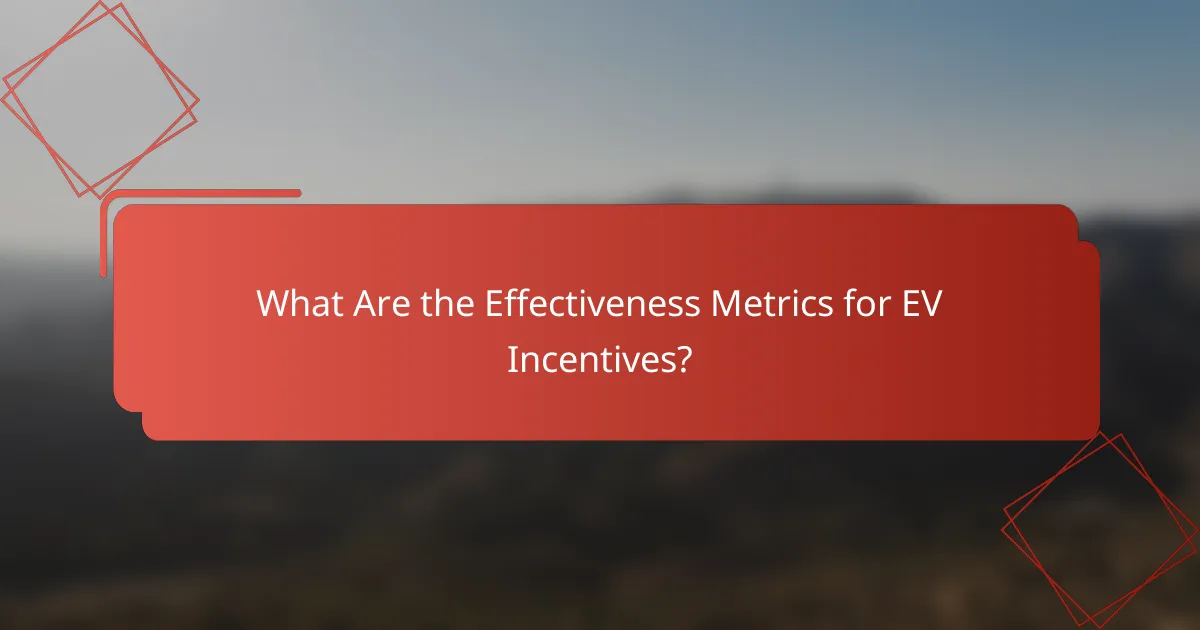
What Are the Effectiveness Metrics for EV Incentives?
The effectiveness of electric vehicle (EV) incentives can be measured through various metrics that assess their impact on sales, costs, and consumer satisfaction. Key metrics include sales growth analysis, cost-benefit analysis, and consumer satisfaction surveys, each providing insights into how well these incentives encourage EV adoption.
Sales growth analysis
Sales growth analysis examines the increase in EV sales following the introduction of incentives. This metric helps determine whether financial incentives, such as tax credits or rebates, effectively stimulate consumer purchases. For instance, regions offering substantial rebates often see sales increases of 20-50% compared to areas without such incentives.
When analyzing sales growth, consider the time frame and external factors, such as fuel prices and charging infrastructure development, which can also influence EV demand. Tracking sales data over multiple quarters can provide a clearer picture of incentive effectiveness.
Cost-benefit analysis
Cost-benefit analysis evaluates the financial implications of EV incentives for both governments and consumers. This analysis weighs the costs of providing incentives against the expected benefits, such as reduced emissions and lower fuel costs for consumers. For example, a government might invest millions in incentives but save even more in healthcare costs due to improved air quality.
When conducting a cost-benefit analysis, it’s essential to include both direct costs, like rebates, and indirect costs, such as infrastructure investments. A thorough analysis can help policymakers decide the most effective incentive structures and funding allocations.
Consumer satisfaction surveys
Consumer satisfaction surveys gauge the effectiveness of EV incentives from the end-user perspective. These surveys can reveal how satisfied consumers are with the incentives, their overall EV ownership experience, and whether incentives influenced their purchase decisions. High satisfaction rates often correlate with increased adoption rates.
To maximize the usefulness of these surveys, include questions about the clarity of incentive programs, ease of access, and the perceived value of the incentives. Regularly conducting these surveys can help identify areas for improvement and adapt incentive programs to better meet consumer needs.
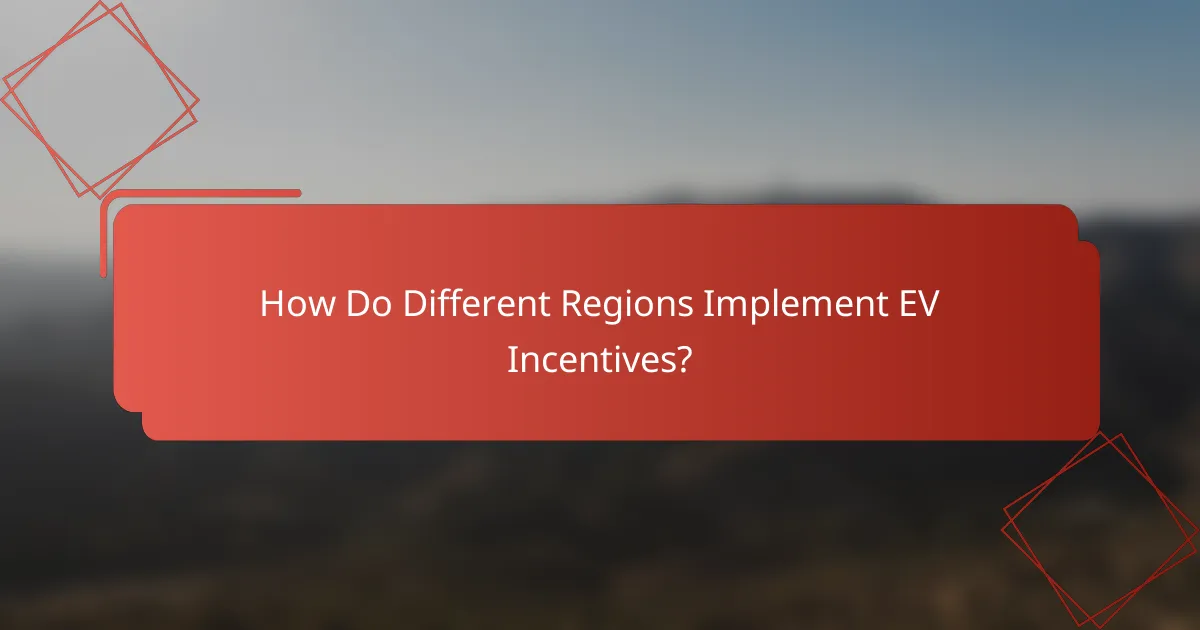
How Do Different Regions Implement EV Incentives?
Different regions implement electric vehicle (EV) incentives through various programs aimed at encouraging adoption. These incentives can include rebates, tax credits, and grants, tailored to local needs and regulatory environments.
California’s Clean Vehicle Rebate Project
California’s Clean Vehicle Rebate Project (CVRP) offers financial rebates to individuals and businesses purchasing or leasing eligible electric vehicles. Rebates can range from approximately $2,000 to $7,000, depending on the vehicle type and the buyer’s income level.
To qualify, applicants must meet specific criteria, including residency in California and the purchase of a new, eligible EV. The program is designed to promote cleaner air and reduce greenhouse gas emissions in the state.
New York’s Drive Clean Rebate
New York’s Drive Clean Rebate provides a straightforward rebate for the purchase or lease of electric vehicles, offering up to $2,000 for eligible models. This program aims to make EVs more affordable and accessible to New Yorkers.
To receive the rebate, buyers must purchase or lease a qualifying vehicle and apply through participating dealerships. The rebate is applied at the point of sale, simplifying the process for consumers.
European Union incentives
The European Union offers various incentives to promote electric vehicle adoption across member states, including purchase grants, tax reductions, and charging infrastructure investments. These incentives vary widely by country, with some offering rebates of several thousand euros.
For instance, countries like Germany and France have implemented substantial financial incentives, while others may focus on developing charging networks. Consumers should check local regulations and available incentives to maximize benefits when purchasing an EV in the EU.
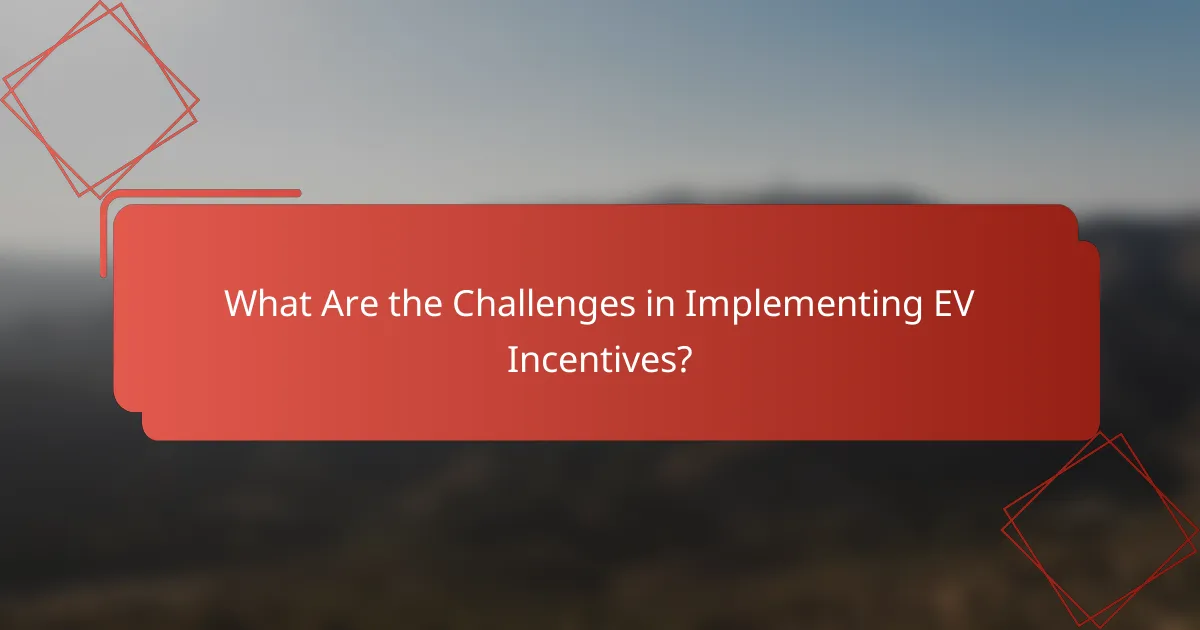
What Are the Challenges in Implementing EV Incentives?
Implementing electric vehicle (EV) incentives faces several challenges that can hinder their effectiveness and reach. Key issues include budget constraints, public awareness, and the complexity of regulatory frameworks.
Budget constraints
Budget constraints are a significant challenge in implementing EV incentives, as governments must balance funding for various programs. Limited financial resources can lead to reduced incentive amounts or the elimination of programs altogether.
For example, a government may allocate only a few million dollars to EV incentives, which may not be sufficient to cover the demand from consumers. This can result in long waiting lists or a lottery system for those seeking rebates or tax credits.
To address budget constraints, policymakers should consider phased implementations or targeted incentives that focus on specific demographics, such as low-income households. This approach can maximize the impact of available funds while promoting equitable access to EVs.
